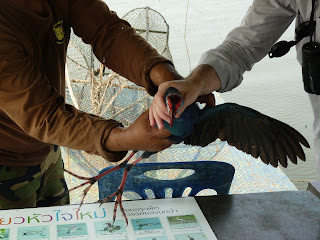It only seems a short time ago since we were back in school after the Christmas break having seen some excellent birds throughout Thailand with Richard and Gaynor. We had been especially impressed by the mountain of Chiang Dao and the nearby Malee Nature Lover's Resort. The name does no justice to the place! Eunice and I decided to drive north this time and stop at Beuang Boraphet near Nakorn Sawan in search of duck. It is the largest natural freshwater lake in Thailand. We hired a boat for three hours, which cruised across the water and took us close to some excellent birds.
Purple Swamphen is a common bird here which tries to get at the fish inside the fishermen's nets. Unfortunately, they can get in but not out. Our boatman worked for the Parks Department and released as many as he could find as we cruised the lake.
I even got the chance to handle one myself.
We came across a big flock of Glossy Ibis which took to the air in an impressive show of iridescent plumage.
At last we caught up with both male and female Siberian Rubythoat
which showed really well eventually.
Why is it that I seem to struggle to see Coot wherever I go? At last, what a mega!
So on to Chiang Dao which took a total of nine hours driving to reach from BKK.
It was worth it with good views but bad photographs of both male and female Hume's Pheasant, Rufous-flanked Scimitar Babbler and a very obliging flock of Spot-winged Grosbeak to name but a few highlights.
Another day we pressed further north to Doi Ang Krang which is up against the Myanmar border. Frank got shelled when he visited 15 years ago in a dispute between the Thais and Burmese but we had no such trouble, although I am told it still happens from time to time.
The main problem is the loss of habitat created by extensive burning of the forest for clearance. The air was thick with smoke that stung the eyes and caught in the throat. As evening drew on it reminded me of the 19century folk songs that describe the furnaces of Sheffield and liken it to hell. We were told the reasons were twofold, to clear the undergrowth to encourage the lucrative growth of mushrooms and to create a firebreak. Well they are certainly succeeding with the latter.
Despite the destruction, there are some areas of forest which remain untouched and we discovered good birds such as this Red-faced Liocichla and a very obvious Scaly Thrush which was being spooked by a Changeable Hawk Eagle hanging around in the trees nearby.
Back to Doi Chiang Dao for a second trip up the mountain. You have to start very early, about 5.30, and drive up very rough tracks to the mountain. This takes about an hour but you arrive just as the day is breaking and hear the forest come to life around you. There is rarely anyone else about and the tranquility is almost religious.
Flycatchers put in a great showing with Rufous-throated Flycatcher and the male slaty-backed Flycatcher showing particularly well.
As always, I end up with some female flycatchers to identify at a later date. Anyone any thoughts on the one below? I think it could be Slaty Blue Flycatcher or Slaty-backed Flycatcher but any comments gratefully received. It looked quite a bit smaller and darker than the Slaty-backed I've seen before.
Spot-winged Grosbeak was a surprise beside the Sub Station but when I read through the records it has been fairly regular here.


























